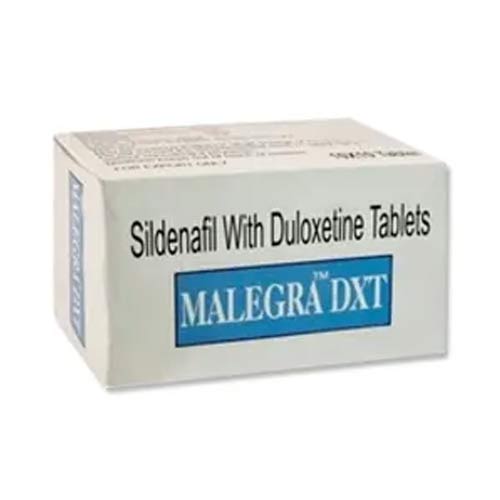Description
Sildenafil is a vasoactive agent used to treat erectile dysfunction and reduce symptoms in patients with pulmonary arterial hypertension (PAH). Sildenafil elevates levels of the second messenger, cGMP, by inhibiting its breakdown via phosphodiesterase type 5 (PDE5). PDE5 is found in particularly high concentrations in the corpus cavernosum, erectile tissue of the penis. It is also found in the retina and vascular endothelium.
Duloxetine is a drug which primarily targets major depressive disorder (MDD), generalized anxiety disorder (GAD), pain related to diabetic peripheral neuropathy and in some countries stress urinary incontinence (SUI). Duloxetine is a selective SNRI (selective serotonin-norepinephrine reuptake inhibitor)used for the acute and maintenance treatment of major depressive disorder (MDD), as well as acute management of generalized anxiety disorder.
Malegra DXT consists of 100mg of Sildenafil Citrate and 30mg of Duloxetine, which act simultaneously to maintain an erection and delay premature ejaculation. The effect comes in half an hour and lasts up to 6 hours. The recommended dose of Malegra DXT is 65 mg (tablet floor). You can take it no more than once a day. The maximum dose of Malegra DXT, which can be taken per day, is 130 mg (one tablet). The tablet is taken orally with the necessary amount of water with 40-50 minutes before the onset of sexual contact. Acting it will be within 4-5 hours after admission.
Pharmacodynamics
Erections are controlled by the parasympathetic nervous system. Upon sexual stimulation, a decrease in vascular resistance is mediated by acetylcholine and nitric oxide resulting in vasodilation. The hemodynamic mechanism of an erection is comprised of five stages. During the latent stage, arterial and carvernous smooth muscle relaxation occurs. Vasodilation results in high levels of blood flow causing the penis to grow to its full size. This stage is called tumescence. During the full-erection stage, blood flow fills penis sinusoids and outflow is restricted. This is followed by the rigid-erection phase during which the cavernous muscles contract causing the penis to become rigid. Little blood flow occurs during this stage. During the final stage, detumescence, the cavernous muscles relax and blood flows out of the penis.
Duloxetine is in a class of medications called selective serotonin and norepinephrine reuptake inhibitors (SSNRIs) and primarily targets major depressive disorders (MDD) and stress urinary incontinence (SUI). Duloxetine is also used to treat pain and tingling caused by diabetic neuropathy (damage to nerves that can develop in people who have diabetes). Known also as LY248686, it is a potent dual inhibitor of serotonin (5-hydroxytryptamine, 5-HT) and norepinephrine (NE) reuptake, possessing comparable affinities in binding to NE and 5-HT transport sites.
Mechanism of action
Sildenafil inhibits the cGMP-specific phosphodiesterase type 5 (PDE5) which is responsible for degradation of cGMP in the corpus cavernosum located around the penis. Penile erection during sexual stimulation is caused by increased penile blood flow resulting from the relaxation of penile arteries and corpus cavernosal smooth muscle. This response is mediated by the release of nitric oxide (NO) from nerve terminals and endothelial cells, which stimulates the synthesis of cGMP in smooth muscle cells. Cyclic GMP causes smooth muscle relaxation and increased blood flow into the corpus cavernosum. The inhibition of phosphodiesterase type 5 (PDE5) by sildenafil enhances erectile function by increasing the amount of cGMP.
Duloxetine is a potent inhibitor of neuronal serotonin and norepinephrine reuptake and a less potent inhibitor of dopamine reuptake. Duloxetine has no significant affinity for dopaminergic, adrenergic, cholinergic, histaminergic, opioid, glutamate, and GABA receptors. The antidepressant and pain inhibitory actions of duloxetine are believed to be related to its potentiation of serotonergic and noradrenergic activity in the CNS. The mechanism of action of duloxetine in SUI has not been determined, but is thought to be associated with the potentiation of serotonin and norepinephrine activity in the spinal cord, which increases urethral closure forces and thereby reduces involuntary urine loss.
Side effects
All medicines may cause side effects, but many people have no, or minor, side effects.Some medical conditions may interact with Sildenafil & Duloxetine.
Tell your doctor or pharmacist if you have any medical conditions.
Common Sildenafil side effects may include: flushing (warmth, redness, or tingly feeling), headache, dizziness, heartburn, nausea, or upset stomach, abnormal vision (blurred vision, changes in color vision), runny or stuffy nose, nosebleeds, sleep problems (insomnia) or muscle pain, back pain.
Common Duloxetine side effects may include: drowsiness, nausea, constipation, loss of appetite, dry mouth or increased sweating.
This is not a complete list of all side effects that may occur. If you have questions about side effects, contact your health care provider.






Reviews
There are no reviews yet.